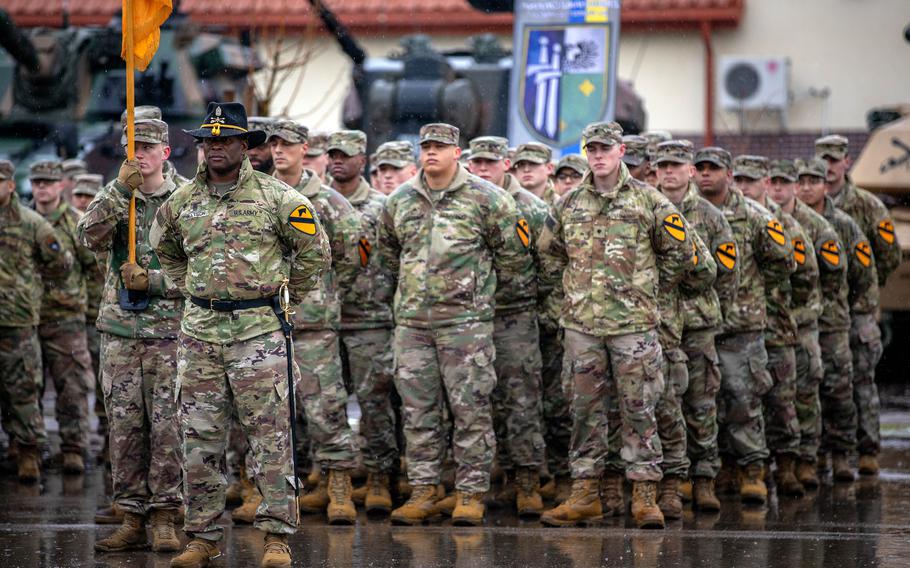
U.S. soldiers of the 1st Cavalry Division stand in formation during a ceremony in Bemowo Piskie, Poland, on Feb. 2, 2023. According to a new Brookings Institution policy analysis, the U.S. should consider modestly increasing troop levels in Poland, particularly in the east near the Suwalki Gap. (Lianne Hirano/U.S. Army National Guard)
The Pentagon will need a basing strategy that thickens defenses in central and Eastern Europe without overextending them, given the larger long-term threat posed by China, according to a new policy analysis.
The Washington-based Brookings Institution, in a series of reports released Wednesday, looked at approaches for U.S. basing worldwide and analyzed how military outposts factor into competing with Russia and China.
“Bolstering security in response to Russian aggression does not require a return to Cold War-era military arrangements in Europe, but it may require Washington to move away from tripwire rotational forward deployments toward more permanent arrangements on NATO’s eastern flank,” wrote Emily Holland, an expert on military strategy at the U.S. Naval War College.
In Europe, the Russia-Ukraine war has disrupted the post-Cold War arrangement that allowed the U.S. military to sharply cut forces from a high of about 400,000 to roughly 65,000 permanently based troops today.
Those numbers have bumped up to around 100,000 since Russia launched a full-scale invasion of Ukraine a year ago, but the increases are in rotational units.
For Washington, the trick will be doing enough to reassure NATO allies and being prepared to respond to threats on the Continent without doing more than is required, according to the report covering Europe.
To achieve that, large troops increases may not be needed, it argues. For example, to counter Russia’s increased troop presence in Belarus, the Pentagon should consider modestly increasing troop levels in Poland, particularly in the east near the Suwalki Gap, the report said.
The gap is a chokepoint that connects Poland to Lithuania and is regarded as one of NATO’s more vulnerable areas should Moscow attempt to seal off the Baltic states from the rest of the alliance.
Poland also has been taking steps to expand its military might, with several multibillion dollar purchases of U.S. equipment in recent years.
More forces in the Baltics also are needed, but Washington should make sure that allies join to ensure fair burden sharing, the report said.
Meanwhile, prospective NATO members Sweden and Finland should be counted on to beef up NATO’s position in the Baltic Sea, the Gulf of Finland and the Arctic, Brookings said.
“The China challenge ensures that the United States will not expand its troop presence to the level seen during the Cold War,” according to Brookings. “The Biden administration must walk a fine line, upholding trans-Atlantic unity on the defense of Europe while also ensuring that European states do not walk back on their promises to shoulder more of the burden.”
In the Pacific, the Biden administration announced last week it had agreed to a deal allowing for more Philippine military sites to be available to rotating U.S. forces.
Such deals, focused on expanding basing rights in Asia, could help fill a “large strategic hole” for the U.S., Brookings said in its Pacific-focused basing report.
Overall, Brookings argued, the current troop levels in the Pacific are about right for the time being.
But “considerable adjustments” may be needed in the future, “not only related to locations and the greater dispersal and hardening of assets but also related to combat capabilities,” the report added.